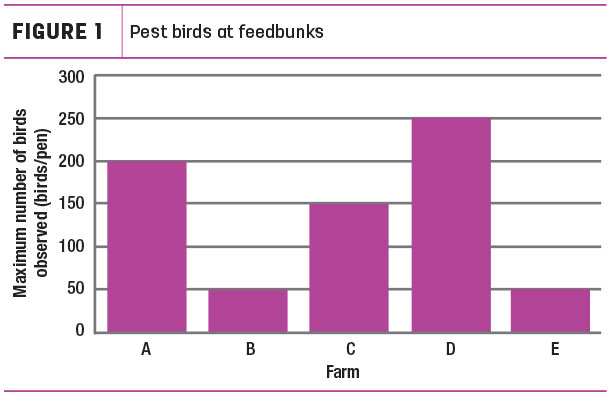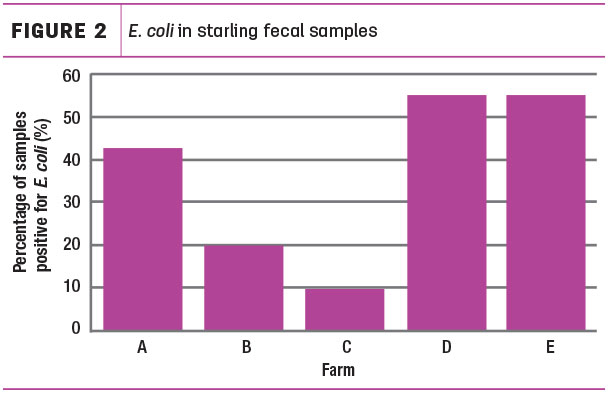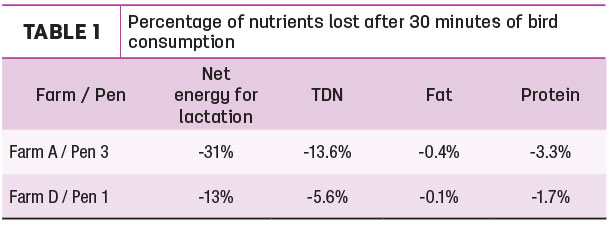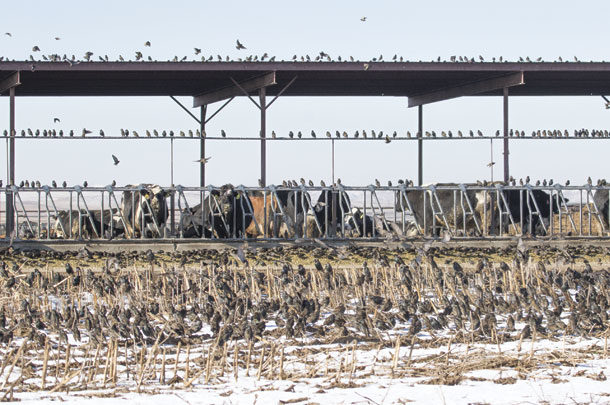How costly are pest birds on dairies? Would you be surprised to know some dairy farmers estimate the cost of feed loss from pest birds to be $55 per cow?
Maybe your cost is higher or lower, but having an estimate of these costs is helpful when choosing the best pest bird deterrence methods for your dairy.
Last year, my research team asked Washington dairy farmers to participate in a survey on pest bird damage. We were surprised to learn that farms reporting more than 10,000 birds per day also reported that salmonella and/or Johne’s disease was present in their herds.
Over 80 percent of farmers identified European starlings as the bird most commonly observed consuming feed. With this information in hand, our team set out to determine nutrient loss in feed from bird consumption and bacteria presence in starling feces. We conducted this study on five dairies across Washington state this past winter (2017-18). Each dairy housed cows in freestall barns and fed a TMR.
Our results shed light on the pest bird problem and how these birds affect cow nutrition and health. Although we don’t have all the answers yet, I hope our key findings below will help you make economically sound pest bird management decisions.
How many birds are eating at the feedbunk?
We installed video cameras at the feedbunk of each lactating cow pen and observed the video footage to estimate the number of pest birds at each feedbunk. Figure 1 shows how bird numbers at the feedbunk differed from farm to farm.

We saw up to 250 birds per pen at one dairy. Farms that had a native raptor (hawk or falcon) present tended to have fewer pest birds eating at the feedbunks.
Finding #1: Attracting native raptors to your farm may help control pest bird populations. Keep this in mind as a potential pest bird deterrence strategy. More birds ate at the feedbunks of pens located at the end of the barn than pens located in the center of the barn.
Finding #2: Birds prefer to eat in a location with an easy escape. Making your feedbunk area less accommodating for birds will help control feed loss at the bunk.
What types of bacteria are found in European starling feces?
On each farm, we collected up to 20 fresh starling fecal samples at feedbunks. These samples were tested for E. coli, salmonella and Campylobacter jejuni bacteria. The number of birds present at the feedbunk did not appear to affect the percentage of fecal samples positive for bacteria.
No samples were positive for salmonella and only one sample was positive for Campylobacter jejuni. It is interesting to note that the Campylobacter jejuni-positive sample was collected from the feedbunk of a maternity pen. Obviously, this is concerning given the relationship between Campylobacter jejuni and cattle abortions. About 39 percent of starling fecal samples were positive for E. coli (Figure 2).

Finding #3: Starlings not only consume cattle feed, but also contaminate feed. Can any of your cow health problems be tracked back to pest birds?
Which nutrients in cattle feed are lost from bird consumption?
You invest time and money into ensuring your cows receive the proper nutrition they need to maintain body condition, produce a quality milk product and be healthy. One way to accomplish this is by feeding a TMR. In theory, a cow should receive a well-balanced diet in every bite of feed; however, pest birds only consume specific components of TMR, causing an imbalance of nutrients.
We collected fresh TMR samples upon delivery to each pen and measured each sample for net energy for lactation, total digestible nutrients (TDN), crude fiber, fat and protein. Each feedbunk had at least one area that was inaccessible to cows, but accessible to birds. After the fresh feed was delivered, we allowed birds to consume feed uninterrupted for 30 minutes.
We then collected a feed sample from the bird-depleted areas of the feedbunks and analyzed them for the same nutritional contents as the fresh feed samples. There were some interesting examples of how birds depleted feed quality in only 30 minutes (Table 1).

Finding #4: A ration can lose up to 31 percent of the net energy for lactation in the TMR in only 30 minutes. Both farms had a similar number of birds consuming feed when samples were collected. This leads us to believe that the feed components may have influenced bird consumption.
Farm A and Farm D fed different diets to their lactating cow pens, where Farm A had a TMR that contained more corn than Farm D’s TMR. We are taking a closer look at this to determine whether the types of feed components we use could be altered to make cattle feed less attractive to birds.
Finding #5: Birds prefer to eat without competition from cows. We noticed on several farms that the feed truck delivered fresh feed while the cows were being milked. When this happened, birds would immediately flock to the unattended fresh feed and begin eating, without any competition.
Depending on the time interval between fresh feed delivery and the cows returning from milking, birds could have ample time to pick out the feed components they want, leaving leftovers for the cows. Even if your cows return from milking only 30 minutes after fresh feed delivery, birds can deplete the net energy for lactation by nearly one-third before the cows return.
In summary, several factors should be considered when calculating the cost-benefit analysis of pest bird management practices on dairies. Although feed consumption is the most commonly identified loss from pest birds, the degradation of feed quality and disease transmission should not be forgotten.









